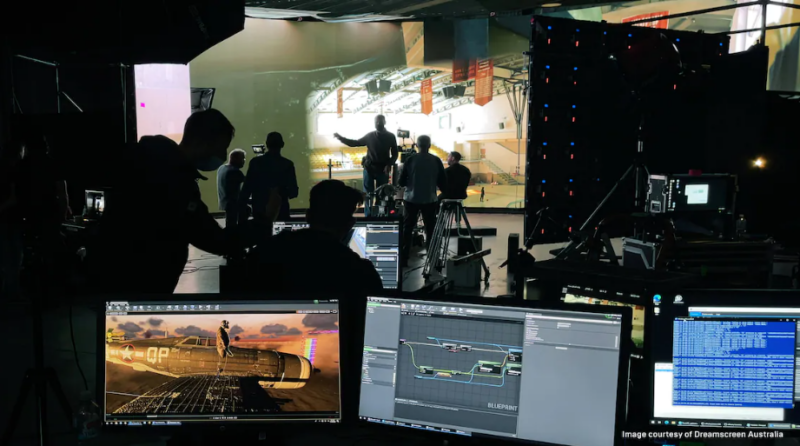Is VRTC the Next Big Thing?
There has been a lot of discussion lately about the use of Virtual Realty (VR) technology. One of the applications being touted as ripe for VR is virtual meetings — a Virtual Reality Telconference (VRTC) if you will.
But will VRTC be the next big leap in meeting technology?

Imagine getting ready for your next meeting at work. You are at home, so you put on your VR headset and launch the meeting application. You are transported to a virtual room where you take a seat at the conference table. Others also join the table, some that are in the office together as well as others in remote locations like yourself.
Each participant is represented by a computer generated avatar inside the room. The animated presenter starts the meeting and triggers content that seems to float in front of you. Then a 3D model of your latest product appears over the table and the participants in the room can manipulate the object in 3D space to explore it’s form and functionality.
The meeting ends, and you remove your headset finding yourself back in your living room.
On the surface, it seems like a no-brainer. The efficiency of a video teleconference coupled with immersive content and interactive 3D visualization seems hard to find much fault with. However, does the VRTC experience actually promote better collaboration and teamwork?
Upon closer inspection, VRTC may actually be less effective than current video teleconferences. In what way?
No live video of participants.
The main draw of adding video to traditional teleconferences is to be able to actually see the other participants. We’ve all heard that communication is 7 percent words, 38 percent tone of voice and 55 percent body language. Adding video added the other 55 percent of communication by allowing participants to see each others facial expressions and body language as they speak and listen to one another, thereby creating more effective communication than is achieved by audio alone. A virtual avatar does not offer the same advantages or convey the real time expressions and body language of the participants.
Observed participation.
Many companies also leverage video in their conferences as an accountability tool. In a standard audio conference and employee can call in to the conference and then leave the room, go eat breakfast, answer email, etc. and the meeting organizer would never know the wiser. Adding video adds accountability to each participant as they know they are on camera. This means that participants are more likely to pay attention and be present at their computer during the conference. Again, a virtual avatar would be present in the VRTC room, but wouldn’t create the same accountability for the participant. Just like with audio, no one would know if participants are actually engaged in the meeting and the content.
Eye Contact.
There has been a lot written about eye contact and its importance in communication so I won’t rehash all that here. I do have a couple quick notes on the subject though. “Increased eye contact is associated with credibility and dominance and lack of contact and blinking are interpreted as submissive.” A virtual avatar won’t make genuine, expressive eye contact and essential communication may be missed altogether.
The Benefit of One to the Detriment of Many.
Depending on the businesses office set up, this could be a real concern. Imagine six people are in the office and put on headsets to get into the virtual room. One remote participant also joins the VRTC from their home. For the person at home, the VRTC experience, even with the drawbacks of digital avatars discussed above, may get a net benefit from being “transported” from the distractions of their home into a virtual room. However, the six people that are in the office are foregoing an in-person, face to face meeting around the table. They are losing out on the opportunity to interact face to face with their peers, all so one person can have an immersive experience remotely. In these cases, I would say the headsets become more of a barrier to good communication than a value added piece of the puzzle.
So is there a way to get the advantages of an immersive, interactive experience and minimize the negative consequences of digital avatars listed above?
The answer may lie in a Mixed Reality (MR) or Augmented Reality (AR) based system instead.
This type of system would utilize a camera on the VR headset to feed the display, or a pair of glasses like HoloLens that impose digital images in the near field over actual items in the real world. Devices like HoloLens use a clear plastic lens, which means for the people in the conference, they can continue to see each others eyes.
If wearing a full VR headset for deeper submersion in a remote or foreign environment, Google has created a way to recreate the semblance of eye contact with people wearing VR headsets.

Image courtesy of http://vrscout.com/author/jonathan360/
They utilize a camera that scans the face and saves the image. Then a QR type code is placed on the front of the VR headset. Anyone looking through their own headset will see that code, and the scanned face is transposed over the headset so they can see each participants full face. The recorded expressions are fixed, so there is still no visual feedback during the communication other than a stare, which can imply hostility. Regardless, the MR/AR scenarios seem like they would allow for immersive and interactive content while still allowing for a more natural face to face meeting and keeping the video portion of the VTC to assure participation as well.
The other question here is does eye contact matter to Millennials and GenZ as much as it has meant to previous generations? Does a generation that uses text and social media as a primary source of communication even care about seeing the other person? Is a digital avatar more acceptable to them? I don’t know that answer, but I do know that there is something visceral about face to face contact, not only for humans, but for animals in general. The digital generations may not actually transcend their nature, and if not, seeing the person they are talking to will still facilitate a better experience.
So what do you think? Is VRTC the next big thing in communications or is it a fun gimmick that will trend for a short time before returning to a traditional camera based environment coupled with MR/AR instead? Weigh in below in the comments section.





